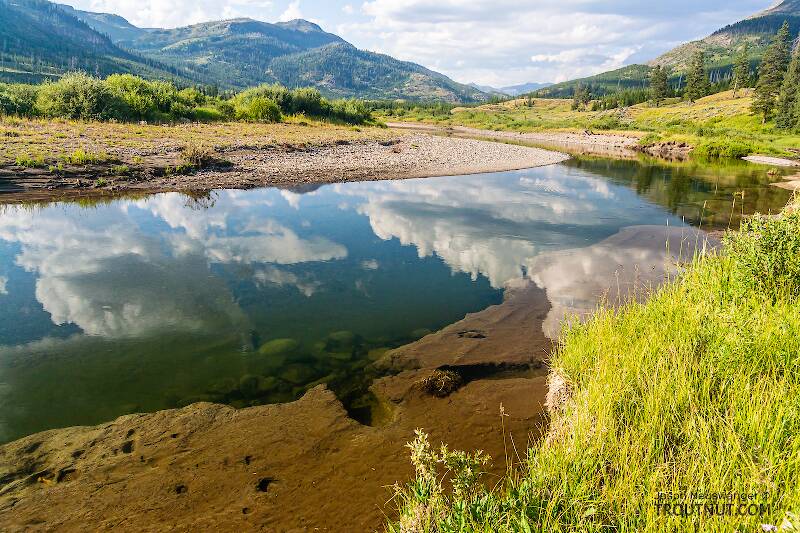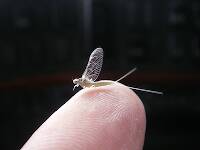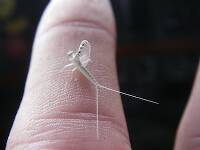
Blue-winged Olives
Baetis
Tiny Baetis mayflies are perhaps the most commonly encountered and imitated by anglers on all American trout streams due to their great abundance, widespread distribution, and trout-friendly emergence habits.
Featured on the forum

It's only barely visible in one of my pictures, but I confirmed under the microscope that this one has a prosternal horn and the antennae are mid-way between the eyes and front of the head capsule.
I'm calling this one Pycnopsyche, but it's a bit perplexing. It seems to key definitively to at least Couplet 8 of the Key to Genera of Limnephilidae Larvae. That narrows it down to three genera, and the case seems wrong for the other two. The case looks right for Pycnopsyche, and it fits one of the key characteristics: "Abdominal sternum II without chloride epithelium and abdominal segment IX with only single seta on each side of dorsal sclerite." However, the characteristic "metanotal sa1 sclerites not fused, although often contiguous" does not seem to fit well. Those sclerites sure look fused to me, although I can make out a thin groove in the touching halves in the anterior half under the microscope. Perhaps this is a regional variation.
The only species of Pycnopsyche documented in Washington state is Pycnopsyche guttifera, and the colors and markings around the head of this specimen seem to match very well a specimen of that species from Massachusetts on Bugguide. So I am placing it in that species for now.
Whatever species this is, I photographed another specimen of seemingly the same species from the same spot a couple months later.
I'm calling this one Pycnopsyche, but it's a bit perplexing. It seems to key definitively to at least Couplet 8 of the Key to Genera of Limnephilidae Larvae. That narrows it down to three genera, and the case seems wrong for the other two. The case looks right for Pycnopsyche, and it fits one of the key characteristics: "Abdominal sternum II without chloride epithelium and abdominal segment IX with only single seta on each side of dorsal sclerite." However, the characteristic "metanotal sa1 sclerites not fused, although often contiguous" does not seem to fit well. Those sclerites sure look fused to me, although I can make out a thin groove in the touching halves in the anterior half under the microscope. Perhaps this is a regional variation.
The only species of Pycnopsyche documented in Washington state is Pycnopsyche guttifera, and the colors and markings around the head of this specimen seem to match very well a specimen of that species from Massachusetts on Bugguide. So I am placing it in that species for now.
Whatever species this is, I photographed another specimen of seemingly the same species from the same spot a couple months later.

Troutnut is a project started in 2003 by salmonid ecologist Jason "Troutnut" Neuswanger to help anglers and
fly tyers unabashedly embrace the entomological side of the sport. Learn more about Troutnut or
support the project for an enhanced experience here.
Goose
Posts: 77
Posts: 77
Goose on Dec 22, 2006December 22nd, 2006, 1:41 am EST
Hi Troutnut! Do you have a photo of a cress bug on a rock or something so I can see what it looks like in a naked-eye sort of way? You have several very close shots, which are neat, but I can't really see what they look like in a stream environment. Thanks
Merry Christmas to all!
Merry Christmas to all!
Troutnut on Dec 22, 2006December 22nd, 2006, 5:23 am EST
I don't have any onstream underwater photos of sowbugs/cressbugs yet. I do have one or two of scuds, though.
Jason Neuswanger, Ph.D.
Troutnut and salmonid ecologist
Troutnut and salmonid ecologist
Jlh42581 on Jan 9, 2007January 9th, 2007, 4:34 am EST
If you want to make an AWSOME cress bug.
Get yourself a size 20 tiemco caddis pupa hook and load it with gray dubbing and then trim, do not shell back it or add legs
Get yourself a size 20 tiemco caddis pupa hook and load it with gray dubbing and then trim, do not shell back it or add legs
Jeremy
Martinlf on Jan 9, 2007January 9th, 2007, 12:25 pm EST
Amen, though you can also tie them bigger, especially for stained or high water.
I like Muskrat fur, and ofen leave it spiky, at least on one side, to suggest legs, unless I do the Ed Shenk thing and spin fur in a dubbing loop and trim to a generally flat shape on the bottom, convex on the top.
I like Muskrat fur, and ofen leave it spiky, at least on one side, to suggest legs, unless I do the Ed Shenk thing and spin fur in a dubbing loop and trim to a generally flat shape on the bottom, convex on the top.
"He spread them a yard and a half. 'And every one that got away is this big.'"
--Fred Chappell
--Fred Chappell
Troutnut on Jan 9, 2007January 9th, 2007, 3:38 pm EST
Yeah, they can be a lot bigger than size 20, probably even up to size 12 in a caddis hook.
Jason Neuswanger, Ph.D.
Troutnut and salmonid ecologist
Troutnut and salmonid ecologist
Jlh42581 on Jan 11, 2007January 11th, 2007, 4:16 am EST
My most productive is a 20
I carry them 14-26
At 26 they dont look like much but they have saved the day more then once.
I carry them 14-26
At 26 they dont look like much but they have saved the day more then once.
Jeremy
Martinlf on Jan 11, 2007January 11th, 2007, 5:13 am EST
Jeremy, how do you trim up your fly? Do you ever pick out the guard hairs and leave it spiky?
"He spread them a yard and a half. 'And every one that got away is this big.'"
--Fred Chappell
--Fred Chappell
Goose
Posts: 77
Posts: 77
Goose on Jan 11, 2007January 11th, 2007, 5:55 am EST
Troutnut: I have some digitals of cress bugs if you'd like them. I can send them to you and you can use what you want. They are from Central, PA. Just let me know how I can forward them to you. I suppose Jpegs. are the best way. I could attach them to an email.
Jlh42581 on Jan 17, 2007January 17th, 2007, 9:26 am EST
I use a very spikey dubbing to begin with. Died hares ear or some other natural. I prefer possum as its REALLY spikey. Sometimes i dont pick it or trim it. just wrap it on. I really found you dont need a shellback and the ones without shellbacking prove better for me.
It goes along the lines of somthing i once read.
"The best imitation of a fly looks the same from every angle"
I pick the sides and trim to get the shape, cut the top and bottom flat.
It goes along the lines of somthing i once read.
"The best imitation of a fly looks the same from every angle"
I pick the sides and trim to get the shape, cut the top and bottom flat.
Jeremy
Quick Reply
Related Discussions
Topic
Replies
Last Reply
10
Jul 27, 2008
by Phillyfired
by Phillyfired






